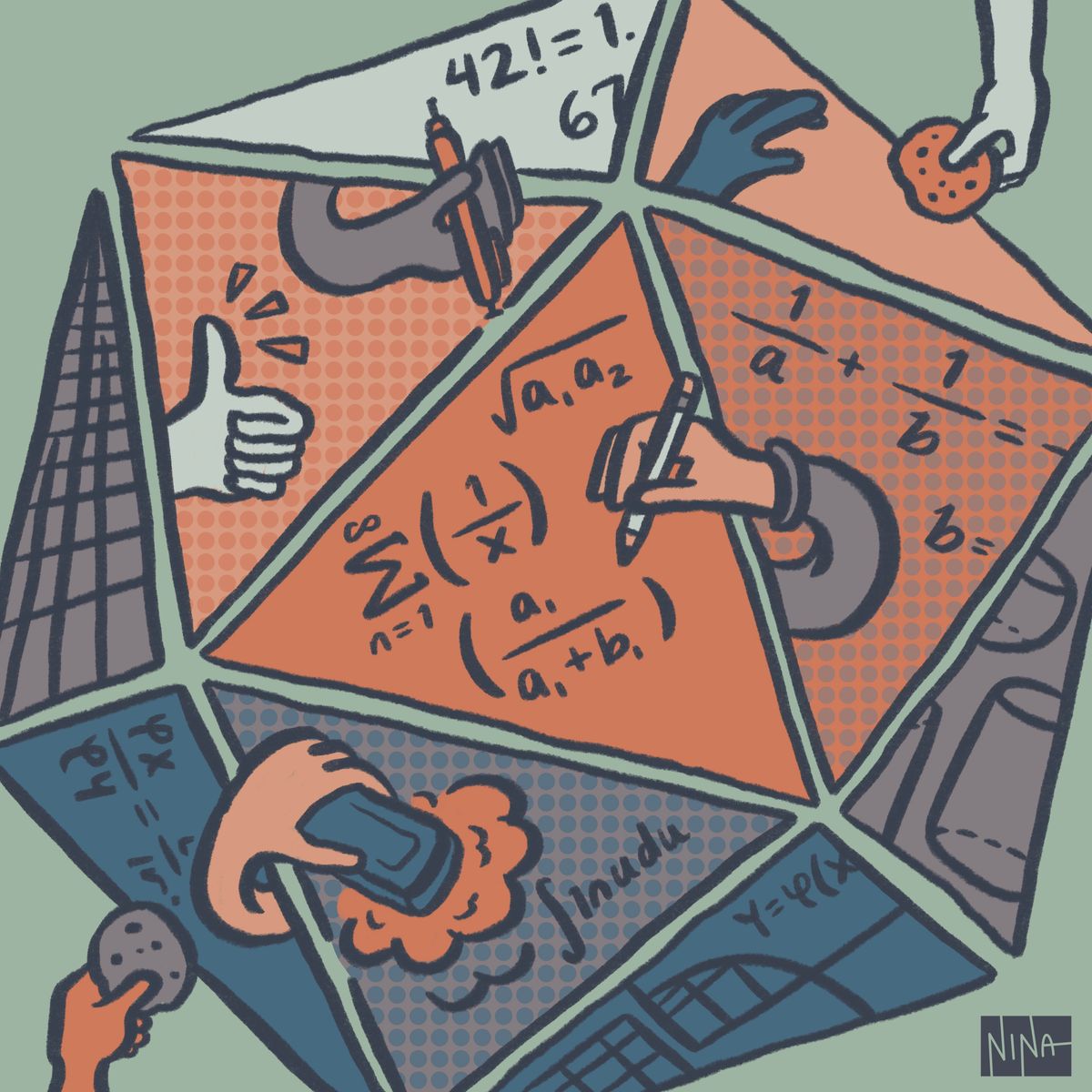Putnam Sessions Add Community to Math Department
The Math department’s Putnam Sessions allow students to come together and prepare for the Putnam Competition, a national exam in mathematics. Staff writer Wenshi Zhao ’27 explores how the sessions ultimately foster a community around a shared passion for math.

On the door of Seeley Mudd’s math lounge, there is a purple poster that would perhaps go unnoticed by anyone except the devoted STEM majors actively looking for math opportunities. It explains the Amherst Putnam Sessions in two short paragraphs, followed by an agenda that lists the topic for the week. Simple, plain, and containing no appealing visuals, the poster reflects a small but vigorous community of young mathematicians growing together, learning from each other, and exploring a mathematical reality that is no less beautiful than the other parts of our world.
The Amherst Putnam Sessions, coordinated by professors of math Ivan Contreras and Nathan Pflueger, are a series of meetings that prepare students for the Putnam competition, a national mathematics exam for undergraduate students. With a historical median score of one point out of 120, the Putnam competition is notorious for its difficulty. Last year, the Amherst team performed exceedingly well in the competition: it was ranked among the top 20 out of more than 400 participating teams, and three students belonged to the national top 500 (William Han ’26, Alan Li ’24, Derek Zhang ’24).
The value of the Putnam sessions, however, cannot be gauged only by students’ performance in the competition. If you walk into Seeley Mudd room 206 on a Thursday afternoon, you would see quite a spectacle: a blackboard filled with overlapping numbers, equations, funny shapes, and nonsensical or even self-contradictory statements; groups of students working together and arguing over potential approaches to solving a problem; Contreras or Pflueger amusingly surveying the work from different groups; and the provided cookies gradually disappearing from their tray. According to Contreras, “there has been increasing interest in the training and the participation of the competition.” This increase can be partially attributed to the general expansion of the math major. However, the importance of the Putnam Sessions as a community building space is also undeniable. “Students enjoy the low-stake, friendly meetings in which we meet and talk and try to solve challenging, fun problems,” said Contreras. “The final result is not our main goal, but our students always surprise us in a good way.”
The sessions are distinctly unique from math classes. “There is not a script,” said Contreras, “the students own the session. They choose the problems. They decide what approaches they would use.” Additionally, unlike a class, the coordinators of the Putnam sessions never give instructions. If you ask for a hint, you almost always get an elusive, vague response. This is intentional, for “there is great pleasure in finding the answers by yourself,” according to Contreras.

Putnam Sessions operate differently from the Putnam competition, and indeed any math competition. Contreras emphasized that “we are proud of the environment that is not competitive” and that people come, not to show their superiority in talent and mastery of techniques, but to “enjoy a pleasant chat about the problems.”Alex van Lidth ’26, a consistent participant in the sessions, said that he comes every week to meet others who share his passion for math. “The session is usually the highlight of the week,” van Lidth added. Another regular participant, Seth Yoo ’26, similarly described the session as “a little energy boost.” For Yoo and others who participate in Putnam Sessions, working out interesting problems is a refreshment, not a burden.
The Putnam sessions’ difficulty is one of its key characteristics. “It keeps us humble,” Contreras said, recounting the session that focused on calculus last year. “[The name] was a little bit misleading because to some, calculus is their first college-level math class, so it shouldn’t be hard … Well, we spent an hour and a half trying to solve one problem. All together, eight students and the coordinator tried on the blackboard, and we couldn’t solve anything.” As one of the coordinators, however, Contreras said he finds it “more funny than disappointing” because “it gives us a sense that mathematics is not always about getting the right answer, it is also about what we accomplish just by thinking about it and about the interesting approaches we came up with.” Far from discouraging the students, the difficulty of the problems provides a glance into the intriguing variety and depth of mathematical knowledge. It inspires the construction of one’s own definitions, attempts to prove one’s own conjecture, and the articulation of vague ideas. It also “gives us a sense of how to deal with frustration. Not being able to solve a very hard problem is totally okay. We just come back in the next time,” said Contreras.
It is also precisely the difficulty and seeming impossibility of the problems that fosters community among participants. This community emerges from the needy to seek help, the joy of collective problem solving, and the shared frustration that immense difficulties provoke. It is the frustration over a problem, the futility of applying common techniques, that lead Yoo and van Lidth to coin the term “smooth Jensen inequality” as a variation of the normal “Jensen inequality” (No worries if you don’t understand, it’s an inside joke). As they say, there are always “funny moments here and there” when people are “grinding” problems together.
It is clear that the core of the session extends well beyond just its original purpose of preparing students for competition—it proves to be a great model of a space that facilitates active learning and community building.





Comments ()